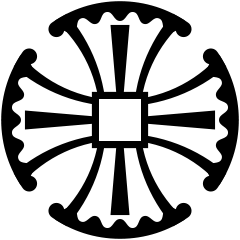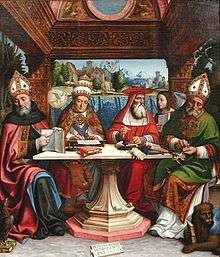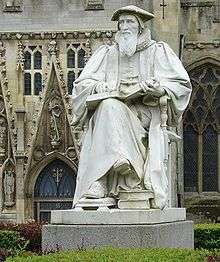Anglican Use
| Part of a series on the |
| Anglican realignment |
|---|
.svg.png) |
| Churches |
| Associations |
| Events |
| Global Anglican Future Conference |
| Related churches |
| People |
| Issues |
| Related topics |
|
|
| Anglicanism Portal |
The Anglican Use is an officially approved form of liturgy used by former members of the Anglican Communion who joined the Catholic Church while wishing to maintain the treasures of the Anglican tradition.
Definition
The Toronto parish of the Personal Ordinariate of the Chair of Saint Peter defines Anglican Use as "the liturgy of The Book of Divine Worship [...] formulated and authorized in response to Pope John Paul II's 1980 Pastoral Provision that allowed Episcopalian priests and laity in the United States to join the Catholic church while preserving elements proper to their Anglican tradition." It gives the name "Ordinariate Use" to the liturgy, since December 2015, of the personal ordinariates for former Anglicans,[3] which is that contained in Divine Worship: The Missal and Divine Worship: Occasional Services. At a time when a specific liturgy for the personal ordinariates was still under preparation, the Anglican Use community in Indianopolis applied the term "Anglican Use" to the Book of Divine Worship liturgy that was then the interim liturgy of the North-American personal ordinariate.[4] The Pasadena parish calls the present form "the Ordinariate Form" and adds that it is unofficially but popularly known as the "Anglican Use".[5] The American National Catholic Register has also distinguished between "Anglican Use" and "Ordinariate Use".[6] These sources are all associated with a geographical area where the Book of Divine Worship has been in use.
With the promulgation of Divine Worship: The Missal for use beginning 29 November 2015, the Book of Divine Worship began to be phased out.[7]
What had been called the Anglican Use Society changed its name in 1916 to Anglicanorum Coetibus Society, echoing the incipit of Pope Benedict XVI's apostolic constitution authorizing the establishment of personal ordinariates for former Anglicans.[1][2]
Personal parishes and personal ordinariates
The personal parishes in the United States founded by former members of the Episcopal Church in the United States were first established in accordance with the Pastoral Provision granted by Pope John Paul II on 20 June 1980,[8][9] which permitted the ordination as Catholic priests of married former clergy of the Episcopal Church for ministry either in such personal parishes or elsewhere in Catholic dioceses of the United States.[10] They were referred to interchangeably as either "Anglican Use" or "Pastoral Provision" parishes, the former term referring to their Anglican liturgical patrimony and the latter referring to the canonical provision that established them as parishes with a distinct character.
On 9 December 2009, Pope Benedict XVI issued the apostolic constitution Anglicanorum coetibus, authorizing the establishment of personal ordinariates for former Anglicans. The first to be established was the Personal Ordinariate of Our Lady of Walsingham for England and Wales in January 2011, followed by the Personal Ordinariate of the Chair of Saint Peter for the United States in January 2012 and the Personal Ordinariate of Our Lady of the Southern Cross for Australia in June 2012. While Pastoral Provision parishes were part of the local geographical Latin Church dioceses, the ordinariates are distinct from the geographical dioceses and have an independent nationwide jurisdiction over their members.
After the establishment in 2012 of a personal ordinariate for former Anglicans in the United States, several Pastoral Provision parishes joined the ordinariate. Among them was St. Mary the Virgin Parish in Arlington, Texas, which in 1994 had become the first Episcopal parish in the United States to transfer corporately into the Catholic Church, being thus, in the words of Monsignor Jeffrey N. Steenson, the ordinariate's first Ordinary, "received into the Catholic Church under the Anglican Use".[11] Others kept their separate identity and were known as Anglican-use parishes, but in 2017 the Holy See declared that it expected all such parishes to be integrated into the ordinariate.[12][13]
History
Origins
The remote origins of the demand for such an arrangement has been ascribed to the Oxford Movement in nineteenth-century England.[9] More immediately the demand arose because of developments in the Episcopal Church in the United States of America in the 1970s, which began to ordain women as priests and bishops, rejected traditional teaching on human sexuality, blessed homosexual unions and ordained those who were openly living in such unions.[14]
In 1977, some of those who desired union with the Catholic Church contacted individual Catholic bishops, the Apostolic Delegate (Archbishop Jean Jadot) and the Congregation for the Doctrine of the Faith in Rome, to inquire about the possibility for married Anglican priests to be received into the Catholic Church and function as Catholic priests.[9]
After the United States National Conference of Catholic Bishops and the Congregation for the Doctrine of the Faith had reacted favorably to the proposals that had been put before them, a formal request for union was presented in Rome on 3 November 1979 for acceptance into the Roman Catholic Church, for steps to be taken to eliminate any defects that might be found in their priestly orders, and that they be granted the oversight, direction, and governance of a Catholic bishop. They offered the allegiance of their whole hearts and minds and souls, and also "with that allegiance the Anglican patrimony that has been ours in so far as it is compatible with, acceptable to and an enhancement of Catholic teaching and worship".[15]
Pastoral Provision
The decision of the Holy See was officially communicated in a letter of 22 July 1980 from the Congregation for the Doctrine of the Faith to the president of the United States episcopal conference, who published it on 20 August 1980.[9]
Though admittance of the Episcopalians in question to the Catholic Church was considered as reconciliation of individuals, the pastoral provision gave them a common group identity.[16] After a period of being subject to the local Latin Church bishop, the bishop could set up personal parishes for them, with the use, within the group, of a form of liturgy that retained certain elements of the Anglican liturgy; and married Episcopalian priests could on a case-by-case basis be ordained as Catholic priests, but not as bishops.[14][17]
An ecclesiastical delegate, a Catholic and preferably a bishop, was to be appointed to oversee the implementation of the decision and to deal with the Congregation.[18]
Implementation
In March 1981, Bishop Bernard Francis Law was appointed ecclesiastical delegate. He was replaced by the Archbishop of Newark, John J. Myers, in 2003 and Kevin W. Vann in 2011. William H. Stetson, a priest of the Prelature of Opus Dei, also served as secretary to the ecclesiastical delegate.[8]
In 1983, the first Anglican Use parish, Our Lady of the Atonement, was established in San Antonio, Texas. Our Lady of Walsingham parish in Houston, Texas, followed the next year.[19] Concern about ecumenical relations with the Episcopal Church prevented the Archbishop of Los Angeles from authorizing the establishment in his archdiocese of personal parishes of the kind envisaged, in spite of requests from two groups whose membership exceeded that of any of the groups for which personal parishes were set up in other dioceses. The petitioners were told that they could only be received as members of the existing ordinary Catholic parishes.[9] Since 1983 over 100 former Anglicans have been ordained for priestly ministry in various Catholic dioceses of the United States.[10][20]
Personal ordinariates
On 9 December 2009, Pope Benedict XVI issued the Apostolic Constitution Anglicanorum coetibus, authorizing the establishment of personal ordinariates for former Anglicans. The first to be established was the Personal Ordinariate of Our Lady of Walsingham for England and Wales in January 2011, followed by the Personal Ordinariate of the Chair of Saint Peter for the United States in January 2012 and the Personal Ordinariate of Our Lady of the Southern Cross for Australia in June 2012. These "Anglican Use ordinariates"[21] were a response to Anglicans outside the United States, and hence beyond the remit of the Pastoral Provision, but they also supplied some of the perceived needs of that previous provision.[22]
Canonical differences between the Anglican Use parishes and the personal ordinariate are outlined in a study published in the 23 January 2012 issue of the National Catholic Reporter.[23] Some of the Anglican Use parishes have joined the ordinariate, but some have not.
Anglican Use liturgy
The Anglican Use is an authorized liturgical variant of the Roman Rite of the Latin Church. The Latin Church includes among its liturgical rites the widespread Roman Rite, the Ambrosian Rite of Milan, the Mozarabic Rite celebrated in the Cathedral of Toledo, the Braga Rite in some parts of northern Portugal, and specific uses of religious orders. The Catholic Church also includes several Eastern Catholic churches, which are alongside the Latin Church but not within it.
The Congregation for Divine Worship gave provisional approval for the Anglican Use liturgy, the Book of Divine Worship, in 1984, an approval rendered definitive in 1987. This book incorporates elements of the 1928 Book of Common Prayer, but the Eucharistic liturgy is from the 1979 Book, with the eucharistic prayers taken from the Roman Missal and the ancient Sarum Rite (with the modern English Words of Institution inserted in the latter).[9] New texts were promulgated by the congregation on 22 June 2012, the feast of English saints Thomas More and John Fisher, namely the Order for Funerals and the Order for the Celebration of Holy Matrimony.[24]
A new liturgy for use in all three personal ordinariates for former Anglicans that had been established from 2011 on was authorized in 2013 and came into use on 29 November 2015.[25] The Book of Divine Worship had been based closely on the United States Episcopal Church liturgy, which had developed in ways different from that of Anglican churches in England and Australia, making it unsuitable for imposing on all personal ordinariates for former Anglicans. Its Order of Mass drew elements also from the original Book of Common Prayer, from different later versions of it, from the Tridentine Mass and from the Roman Rite as revised after the Second Vatican Council.[26]
Those personal-ordinariate communities that had provisionally been using the 1984-approved Book of Divine Worship adopted this new liturgy at the end of 2013. The Holy See's 'Anglicanae Traditiones Commission' that developed the updated form of Anglican patrimonial liturgy used the Book of Divine Worship as its "lead" source.[27] In the new liturgical books for the personal ordinariates, the Congregation for the Doctrine of the Faith and the Congregation for Divine Worship retained the generic title, "Divine Worship", for the entire liturgical provision for the personal ordinariates, dropping the "Book of" naming convention in favour of "Divine Worship: The Missal".[28]
Divine Worship: The Missal, the missal containing the complete expression of the Divine Worship Mass liturgy, began to be used on 29 November 2015, and as of 1 January 2016 the Book of Divine Worship was no longer authorized for use in public worship. As a result, even the Pastoral Provision parishes at that time still remaining outside the ordinariates adopted Divine Worship: The Missal instead of the Book of Divine Worship.
The new missal is "a pastoral variation of the Roman Rite for the members of the Personal Ordinariates in the United Kingdom, Australia, Canada and the United States. [...] This is not an Anglican liturgy separate and distinct from the Roman Rite of the Catholic Church. This is not an Anglican Use Rite. It does not reflect Anglican Eucharistic theology. It is not a Protestant service dressed up as a Catholic Mass. It is the Catholic Mass of the Western Rite, filtered through the Anglican experience, corrected and expressed in an Anglican voice."[25]
See also
References
- 1 2 Ordinariate News, 21 April 2016
- 1 2 Anglicanorum Coetibus Society
- ↑ The Catholic Parish of St. Thomas More, The Ordinariate of the Chair of St. Peter in Toronto: Further Information
- ↑ Pasadena ordinariate website
- ↑ Indianapolis ordinariate website
- ↑ Charlotte Hays, "Modified Liturgy Coming to Ordinariate Parishes in Advent" in National Catholic Register
- ↑ Smith, Peter Jesserer, Our Lady’s Dowry: New Ordinariate Missal Makes Advent History
- 1 2 Stetson, William H., "History of the Pastoral Provision", Office of the Ecclesiastical Delegate for the Pastoral Provision website
- 1 2 3 4 5 6 Jack D. Barker, "A History of the Pastoral Provision for Roman Catholics in the USA", chapter 1 of Cavanaugh, Stephen E., Anglicans and the Roman Catholic Church, Ignatius Press 2011, ISBN 9781586174996
- 1 2 Office of the Ecclesiastical Delegate for the Pastoral Provision
- ↑ Another Anglican Use parish to enter the American Ordinariate
- ↑ Catholic Culture: "Texas Anglican-use parish adopted into Anglican ordinariate"
- ↑ Catholic News Agency, "US Anglican ordinariate expands to include prominent Texas parish"
- 1 2 Richert, Scott P. "Differences Between Anglicanism and Roman Catholicism". Catholicism. About.com. Retrieved 8 March 2012.
- ↑ Cavanaugh, Steve (2011), "Appendix A", Anglicans and Roman Catholics, Ignatius Press, ISBN 9781586174996
- ↑ Letter of the Congregation for the Doctrine of the Faith, I, archived from the original on 4 June 2004
- ↑ Letter, II
- ↑ Letter, V
- ↑ Mueller, Mary Ann (2009-06-17). "'Anglican Use' Catholic Liturgy". Catholic.org. p. 1. Retrieved 12 March 2012.
- ↑ "Cardinal announces establishment of US Anglican ordinariate". 16 November 2011. Retrieved 12 March 2012.
- ↑ Bishop Elliott, Peter J., "Anglican Use Ordinariates and Ecumenism", The Messenger, No. 292, April-August 2010
- ↑ "Anglicanorum Coetibus applies the lessons learned [in North America's Pastoral Provision] to the entire Catholic Church..." Statement of the Executive of the Catholic League on Anglicanorum Coetibus, January 2010 The Messenger, No. 292, April-August 2010
- ↑ Fiteau, Jerry (23 January 2012), "New ordinariate and 1980 pastoral provision: An analysis", National Catholic Reporter
- ↑ http://www.anglicanuse.org/
- 1 2 The Personal Ordinariate of the Chair of Saint Peter: "Divine Worship: The Missal"
- ↑ Patrimony: The Order of Mass for the Anglican Ordinariates
- ↑ Sacra Liturgia, 9 July 2016, "Mgr Burnham speaks at Sacra Liturgia London 2016"
- ↑ 'New Liturgical Book for the Personal Ordinariates', 20 March 2014
External links
- Letter of the Congregation for the Doctrine of the Faith communicating the pastoral provision
- Office of the Ecclesiastical Delegate for the Pastoral Provision
- Anglican Use Society
- Unitatis Redintegratio, Decree from Second Vatican Council
- A Place Has Been Prepared: "Anglican Use" Catholic Parishes (article)
- Historical documents on Anglican-Roman Catholic relations
- Similarities and Differences between Pastoral Provision Parishes and the new Ordinariates



